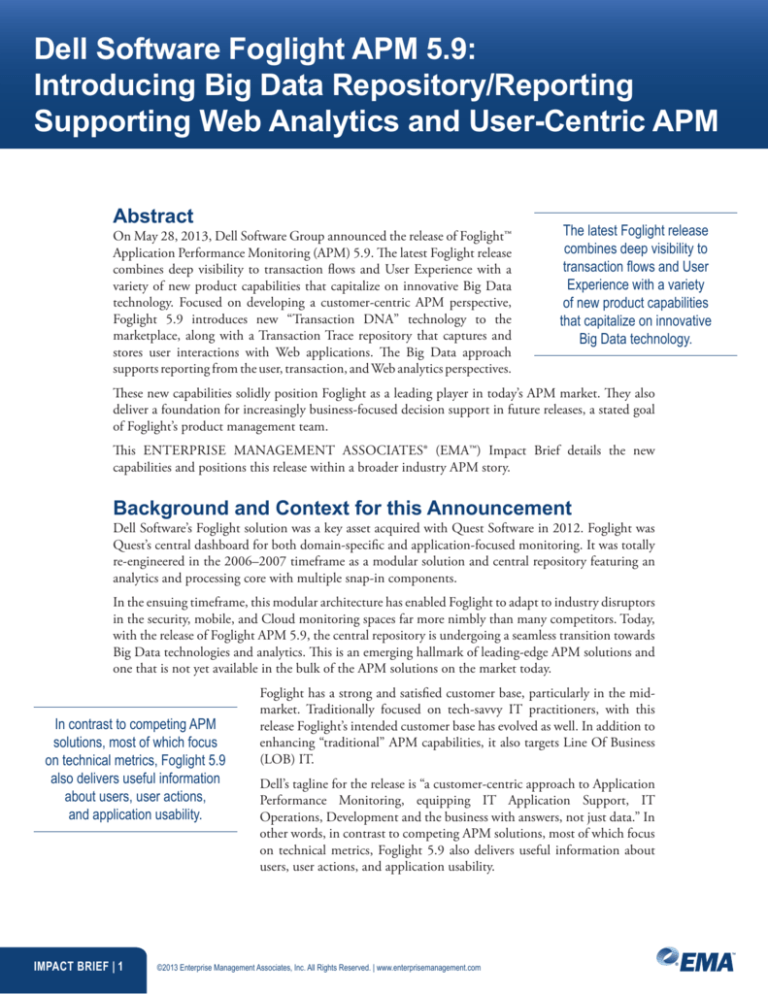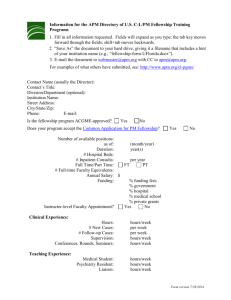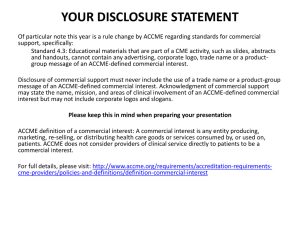
Dell Software Foglight APM 5.9:
Introducing Big Data Repository/Reporting
Supporting Web Analytics and User-Centric APM
Abstract
On May 28, 2013, Dell Software Group announced the release of Foglight™
Application Performance Monitoring (APM) 5.9. The latest Foglight release
combines deep visibility to transaction flows and User Experience with a
variety of new product capabilities that capitalize on innovative Big Data
technology. Focused on developing a customer-centric APM perspective,
Foglight 5.9 introduces new “Transaction DNA” technology to the
marketplace, along with a Transaction Trace repository that captures and
stores user interactions with Web applications. The Big Data approach
supports reporting from the user, transaction, and Web analytics perspectives.
The latest Foglight release
combines deep visibility to
transaction flows and User
Experience with a variety
of new product capabilities
that capitalize on innovative
Big Data technology.
These new capabilities solidly position Foglight as a leading player in today’s APM market. They also
deliver a foundation for increasingly business-focused decision support in future releases, a stated goal
of Foglight’s product management team.
This ENTERPRISE MANAGEMENT ASSOCIATES® (EMA™) Impact Brief details the new
capabilities and positions this release within a broader industry APM story.
Background and Context for this Announcement
Dell Software’s Foglight solution was a key asset acquired with Quest Software in 2012. Foglight was
Quest’s central dashboard for both domain-specific and application-focused monitoring. It was totally
re-engineered in the 2006–2007 timeframe as a modular solution and central repository featuring an
analytics and processing core with multiple snap-in components.
In the ensuing timeframe, this modular architecture has enabled Foglight to adapt to industry disruptors
in the security, mobile, and Cloud monitoring spaces far more nimbly than many competitors. Today,
with the release of Foglight APM 5.9, the central repository is undergoing a seamless transition towards
Big Data technologies and analytics. This is an emerging hallmark of leading-edge APM solutions and
one that is not yet available in the bulk of the APM solutions on the market today.
In contrast to competing APM
solutions, most of which focus
on technical metrics, Foglight 5.9
also delivers useful information
about users, user actions,
and application usability.
IMPACT BRIEF | 1
Foglight has a strong and satisfied customer base, particularly in the midmarket. Traditionally focused on tech-savvy IT practitioners, with this
release Foglight’s intended customer base has evolved as well. In addition to
enhancing “traditional” APM capabilities, it also targets Line Of Business
(LOB) IT.
Dell’s tagline for the release is “a customer-centric approach to Application
Performance Monitoring, equipping IT Application Support, IT
Operations, Development and the business with answers, not just data.” In
other words, in contrast to competing APM solutions, most of which focus
on technical metrics, Foglight 5.9 also delivers useful information about
users, user actions, and application usability.
©2013 Enterprise Management Associates, Inc. All Rights Reserved. | www.enterprisemanagement.com
Dell Software Foglight APM 5.9
With the release of Foglight APM 5.9, Dell has positioned the transaction as the primary point of
interaction and visibility. With this in mind, a new Big Data repository and related analytics store
and analyze disparate data from multiple sources, consolidating it into a common service model of
transaction execution. While this approach enables in-depth coverage of both APM and businessrelated metrics, Dell indicates that the product will continue to evolve towards increasingly businesscentric reporting over time.
New features and capabilities fall into three main categories: the Big Data
repository and analytics, transaction- and user-centric reporting, and
simplification of deployment and usage. The release includes:
Dell indicates that the product
will continue to evolve towards
increasingly business-centric
reporting over time.
• “Transaction DNA” technology, which relies on the Big Data capabilities
to provide detailed and automated insight into transaction paths and
performance. Via a synthesis of network-based Real User Monitoring
(RUM) and browser-based AJAX monitoring, Foglight 5.9 “captures
everything, because often the problem is in the periphery.”1 A key advantage over other APM
solutions is the ability to de-duplicate static transaction-related information. The result is the ability
to collect and store massive amounts of data at the levels of scale necessary for large companies with
thousands of endpoints.
A related benefit is that analysis can be done from both the transaction and the user perspectives.
Detailed reporting related to the transaction itself is provided out of the box. It includes identification
of the user or users impacted by a problem, along with application, infrastructure, and thirdparty dependencies. This is a significant benefit which helps automate prioritization of triage and
remediation tasks. Currently a repository for primarily IT-centric metrics, the Big Data repository
and analytics will support increasingly business-centric types of data analysis in future releases.
• Multi-Dimensional User Experience: In addition to transaction-centric analysis, Foglight 5.9 adds
significant depth to user experience reporting. Foglight User Experience analyzes both network
and browser metrics in the context of the transaction. This context-driven approach is a key
differentiator and new in Foglight 5.9. For example, transactions can be associated with users,
giving insight into questions such as “how many users are impacted?” or “what caused the user’s
problem with this transaction?”
Dell’s new “Transaction Funnel” (see Figure 1) tracks transaction paths and completion rates.
Foglight customers can define and search on any aspect of a transaction, including business-focused
items such as shopping cart content. Or the entire session can be analyzed to determine why and
when the customer exited the transaction. As an example, Foglight 5.9 analytics could search for
common threads among 400 hypothetical customers who did not complete a given transaction.
1
Per a Dell spokesperson
IMPACT BRIEF | 2
©2013 Enterprise Management Associates, Inc. All Rights Reserved. | www.enterprisemanagement.com
Figure 1: Transaction Funnel Analysis
This release also supports detailed out-of-the box reporting of Web analytics, including page and hit
analysis by location, browser, and content type (see Figure 2). The analysis includes “Hit Count” by
Operating System, content category, browser type, and similar factors.
Figure 2: “Pivot Chart” Page and Hit Analysis
IMPACT BRIEF | 3
©2013 Enterprise Management Associates, Inc. All Rights Reserved. | www.enterprisemanagement.com
• Ease of Use: Dell has added a number of features that enable customers
to get up and running very quickly and reduce the amount of time
necessary to configure and administer the Foglight platform. Foglight
5.9 is available as a turnkey virtual or physical appliance which is
pre-configured and includes the network sniffer and RUM products.
Deployment is significantly simplified, and Foglight can be scaled by
adding physical and/or virtual appliances.
Foglight 5.9 is available
as a turnkey virtual or
physical appliance which
is pre-configured and
includes the network sniffer
and RUM products.
Past releases required the installation of separate cartridges for much of
the Foglight functionality. In Foglight 5.9, all of the end user related
functions have been aggregated into the appliances, and only code
drilldown functionality – Java and .NET – remain as separate modules.
Analytics and reporting are also more automated than in past releases (which required customers to
manually relate Java transactions to end user transactions, for example). Customers can now define
end-user transactions by frame, URL, or similar parameters and Java transactions automatically
attach based on the information provided. Foglight also recognizes IP addresses of Virtual Machines
(VMs) and automatically models virtual devices accordingly.
Differentiators and Key Value Propositions
• Collects and stores rich set of user- and transaction-focused information: The Big Data repository,
containing all relevant metrics for every user, is a key differentiator. It delivers a more granular
approach to storing transaction-related metrics, particularly in comparison to the data aggregation
methodologies favored by many competing solutions.
• Both user-and transaction-focused insight, out of the box: The richness of data in the repository
makes it possible to analyze and report on transactions from both technical and business/user
perspectives. Customers have access to reports showing all users impacted by a given transaction
trace, for example. Conversely, these enhancements also position each
“bit” of transaction-related data in context to the entire transaction.
For example, while Foglight monitors asynchronous AJAX requests at
the browser, understanding the impact of a menu click requires that
Foglight’s Web analytics
the AJAX request is linked with the “back-end” transaction as well.
capabilities enable technical or
• Business context: While the Foglight solution has traditionally been
positioned primarily as a tool for technical users, it is increasingly
evolving towards far more business-focused reporting. Particularly
relevant to eCommerce and eTail businesses, Foglight’s Web analytics
capabilities enable technical or business users to drill down into enduser actions to understand how well a company’s Web applications
support business goals and objectives.
business users to drill down into
end-user actions to understand
how well a company’s Web
applications support business
goals and objectives.
EMA Perspective
Foglight 5.9 is an ideal example of what can happen to a great product when it is acquired by a softwarefocused company. Dell has repeatedly stated its intent to build a set of end-to-end IT management
software solutions, and the acquisition of Quest in 2012 seemed to deliver on that promise.2 Far too
often, however, acquisitions vanish into a “black hole” within major companies, never to be seen again.
The continued development of the Foglight solution and the leading-edge features in 5.9 demonstrate
Dell’s commitment to the software side of the business. They also display savvy design on the part of
the Foglight product team, as the product continues to significantly improve over time.
2
See EMA Brief on Dell’s acquisition of Quest at: http://www.enterprisemanagement.com/research/asset.php/2323/
Dell-Delivers-on-Promise-of-End-to-End-IT-Management-with-Acquisition-of-Quest
IMPACT BRIEF | 4
©2013 Enterprise Management Associates, Inc. All Rights Reserved. | www.enterprisemanagement.com
The announcements showcased in this release take Foglight to the next level
of functionality with Big Data-driven analytics and a new focus on businesscentric reporting. Few APM vendors as yet are using Big Data techniques
and repositories to store the breadth and depth of transaction- and userrelated data we see in Foglight 5.9. This, in turn, provides a foundation
to branch beyond APM and into Web analytics reporting, which has
traditionally required an entirely different set of products.
The continued development
of the Foglight solution and
the leading-edge features
in 5.9 demonstrate Dell’s
commitment to the software
side of the business.
In future releases, additional support for native mobile applications,
currently addressed by HTML monitoring capabilities, would be “nice to
have.” With the breadth of data being collected and stored, customers will
also likely request more open access to the Foglight Big Data repository. Development of an API
providing access to the repository by third-party analytics tools would be a significant value-add.
In the meantime, EMA Analysts see this release as a key milestone for Foglight. It marks the product’s
entry into the Big Data arena and positions it among the most innovative APM solutions on the market.
About EMA
Founded in 1996, Enterprise Management Associates (EMA) is a leading industry analyst firm that provides deep insight across the full
spectrum of IT and data management technologies. EMA analysts leverage a unique combination of practical experience, insight into
industry best practices, and in-depth knowledge of current and planned vendor solutions to help its clients achieve their goals. Learn
more about EMA research, analysis, and consulting services for enterprise line of business users, IT professionals and IT vendors at
www.enterprisemanagement.com or blogs.enterprisemanagement.com. You can also follow EMA on Twitter or Facebook.
2689.062013
IMPACT BRIEF | 5
©2013 Enterprise Management Associates, Inc. All Rights Reserved. | www.enterprisemanagement.com









